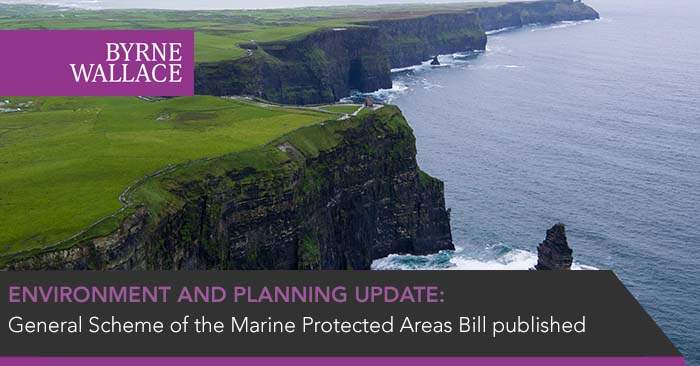General Scheme of the Marine Protected Areas Bill published
Friday, 10 March 2023
On 13 December 2022 the Government approved the General Scheme of the Marine Protected Areas Bill.
“Marine Protected Area” (“MPA”) as defined in the General Scheme means “a geographically defined area of marine character or influence which is protected through legal means for the purpose of conservation or protection of specified species, habitats or ecosystems and their associated ecosystem services and cultural values, and managed with the intention of achieving stated objectives over the long term”.
The General Scheme is available at the following link: gov.ie - General Scheme of Marine Protected Areas Bill 2022 (www.gov.ie)
Once enacted, the proposed Bill would provide a framework for the designation of MPAs and is particularly relevant for offshore wind farm developers.
Ocean Environment Policy Statement
The General Scheme sets out that the Minister for Housing Local Government and Heritage shall publish an Ocean Environment Policy Statement. This Statement will set out priorities for the marine environment and targets for the designation of MPAs. This policy statement shall amongst other things take into account “other policies of Government such as renewable energy policies, fishery and aquaculture policies”.
When identifying MPAs the Minister must take into account the priorities of the Ocean Environment Policy Statement and those listed in Head 7, Sub-section 5 of the General Scheme, which as well as conservation measures, includes sustainable development, energy security, climate policy and associated EU and National plans.
Identifying potential MPAs
Head 13 of the General Scheme appears to try and balance the government’s priorities for areas to be identified as MPAs quickly but also to encourage offshore wind energy development. The explanation to this section notes that it is included “for the rapid identification of areas which are not suitable for Offshore Renewable Energy development in order to pursue national climate adaptation goals and the Government’s decision of 14 September 2022 (S180/20/10/177) to prioritise ORE plans and projects”. It will be particularly relevant for the seven offshore projects which have recently been granted Marine Area Consent (“MAC”).
In the committee stage of pre-legislative scrutiny, Mr Richard Cronin (Principal Adviser for the marine environment in the Department of Housing, Planning and Local Government) was asked about this section and noted that “the Minister reconvened part of the expert body that produced the advisory report to carry out the ecological sensitivity analysis on that area of the eastern seaboard in order to bring greater certainty to those sites and to avoid conflict between their locations and ecologically sensitive or unique features that may need protection. This mitigation piece is already in train with the aim of being delivered this April. Head 13 could still be used for those designations in the Irish Sea”.
Designation of MPAs
The designation of a MPA will have an impact on the ability to develop energy infrastructure in that area. However, Head 14, Subsection 2 of the General Scheme guarantees the rights of holders of existing rights, consents, authorisations, licences and leases granted on or before the date of designation of the MPA.
The Minister is required take into account criteria in schedule 1 when identifying, designating or reviewing conditions for areas designated or to be designated MPAs. Offshore renewable energy development is listed in the schedule under Production of energy by the inclusion of “renewable energy generation (wind, wave and tidal power), including infrastructure”, and also under the “transmission of electricity and communications (cables)”. However, the Minister may also seek guidance on Pressures which includes “physical disturbance to seabed (temporary or reversible)” and “physical loss (due to permanent change of seabed substrate or morphology and to extraction of seabed substrate”. These pressures will likely be associated with offshore wind energy infrastructure, including the common monopile structures which have foundations fixed into the seabed.
Public participation in the process
One key element of the General Scheme is the use of public consultation and this will be a key time for offshore energy developers and other key stakeholders to assert their position.
The General Scheme provides for consultation on the Ocean Environment Policy Statement. The General Scheme provides for a consultation period of 4 weeks from the date of publication of the draft. However, there has already been some criticism of this time period during the committee stage.
There is an element of public participation in the advice provided to the Minister. There may be scope for offshore wind energy developers to engage with the process by providing advice in the capacity as a specialist body or through a representative group.
Where the Minister has prepared a proposal to designate an area as a MPA, he or she must notify the public in one or more national newspapers and by publication on the relevant government website. The public can make submissions to the Minister within four weeks of the publication and these submissions must be taken into account.
Additionally, the Minister must notify any person with an interest in or over a maritime area it proposed to designate. Such interest holders may give notice to the Minister with particulars of grounds of objection within 12 weeks of publication of the notice. The Minister will consider the objection and publish a determination. Proposals for MPA designation may be accepted, rejected or amended following public consultation.
Designation of Marine Protected Areas
Head 6 of the General Scheme provides that the Minister shall aim to designate up to 10% of the maritime area as Marine Protected Areas as soon as practicable after commencement of this Act and up to 30% of the maritime area as Marine Protected Areas by 2030 and may designate a larger area if necessary under European or International strategies or international conventions, or national policies or strategies.
Head 13 provides that where there is an urgent need in the national interest to identify Marine Protected Areas unsuitable for specific types of activity, the Minister may in consultation with the Minister for Environment, Climate and Communications, and the Expert Body, or other specialist body develop designation proposals in specified locations.
Conclusion
It will be crucial for Offshore wind farm developers to ascertain if the proposed area(s) for their offshore development(s) will fall within the initial 10% and the subsequent 30% Marine Protected Areas and also crucially to be aware of and mitigate any plans to include such territory in the Marine Protected Areas unsuitable for specific types of activity.
For further information on the Marine Protected Areas Bill 2022 and other climate action measures, or general legal advice on this topic, contact Fergal Ruane, Christopher Woods or any other a member of the ByrneWallace LLP Environment and Planning Team.

